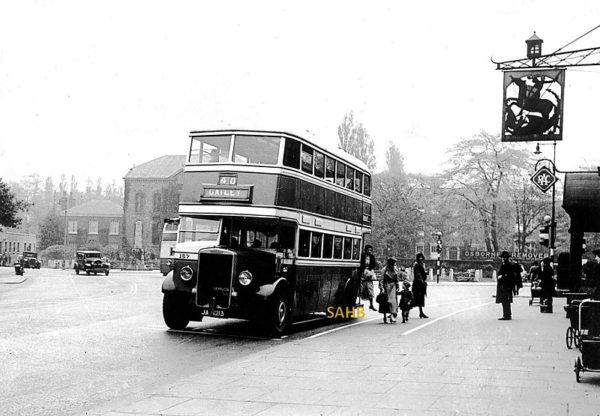
Except for one thing, this 1935 Leyland Titan would be a reasonably ordinary double-decker bus, snapped by an enthusiast during its daily work in a suburb of south Manchester: the village of Cheadle, Cheshire. It is stopped outside the White Hart Hotel – which survives today. The date is almost certainly before World War II, judging by the other vehicles and the clothes of the alighting passengers.
Except for… the words ‘Gearless Bus’ clearly displayed on the radiator. We shall return to that later. It is a Leyland Titan TD4c model, chassis number 7384 and Fleet Number 167 (seen under the driver’s windscreen) in the fleet of Stockport Corporation. The body was built by Leyland themselves, and in bus language it is an H28/24R. H stands for High body – and those of you who live in the North West might have seen in earlier times the incredibly low bridge under the railway lines at nearby Cheadle Hulme station that called for a series of low-bodied double-deckers operated, we think, by the delightfully named North Western Road Car Company. They were most inconvenient to ride in; four-abreast seats upstairs and a gangway on one side made it difficult for passengers to manoeuvre past each other, and that gangway encroached upon the downstairs headroom on one side – so passengers bumped their heads when standing up. The high-bodied bus in our Snapshot, routed to Gatley, was therefore definitely not going via that bridge. 28/24 stand respectively for upstairs and downstairs seating – and R stands for rear entrance, just where we can see the passengers.
And why is it gearless? The Leyland Titan TD4c models were fitted with a Lysholm-Smith torque-converter transmission. Unlike a simple fluid drive, where an impeller (driven by the engine) drives a turbine (connected to the road wheels), the torque converter has an extra element: the stator. At low road speeds (for example when accelerating from rest), this sends fluid back to the impeller and multiplies the torque.
A test report in Commercial Motor for 19th January 1934 heaped much praise on this system for its ‘quite uncanny smoothness of drive’ and its mechanical lock-up: this eliminated energy waste through slippage when the bus was cruising, and saved fuel by acting as a freewheel when disconnected. The report added: ‘There is no jerk whatever and passengers can pass in comfort to their seats without being thrown off their balance as they often are when the throttle of a normal bus is eased for each gear change.’ There are no beaming smiles on the faces of the descending passengers, but they do look calm and unbruised!
The system was no obscure experiment destined to be removed after a few months. Fleet No. 167 gave sterling service until withdrawn in 1958.
Picture courtesy of G. H. F. Atkins – part of the Dickie Grenfell collection







Leave a Comment